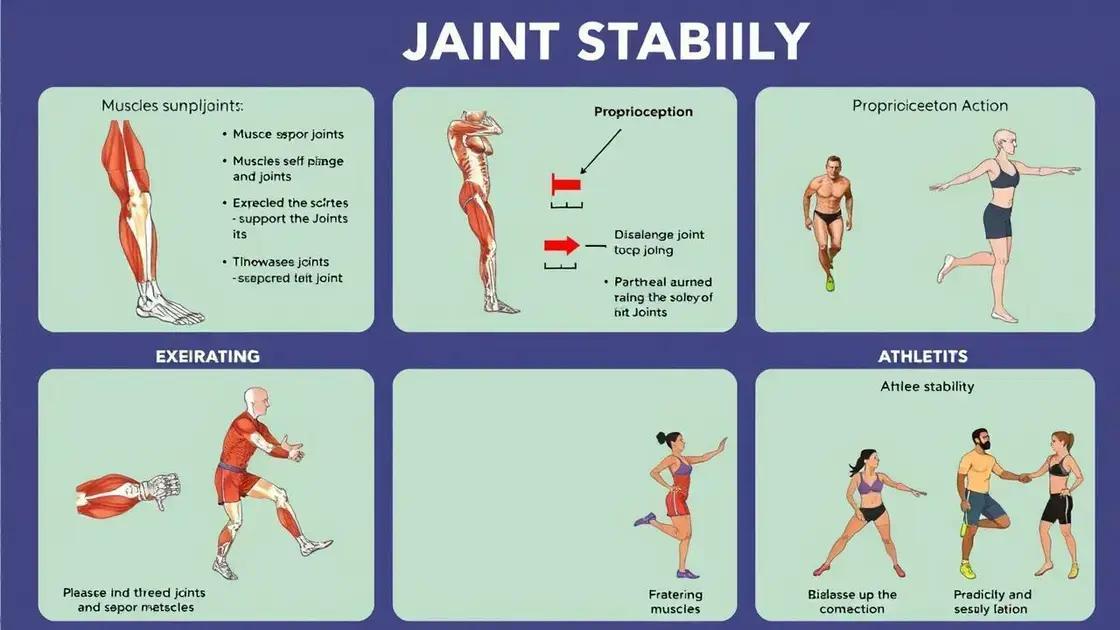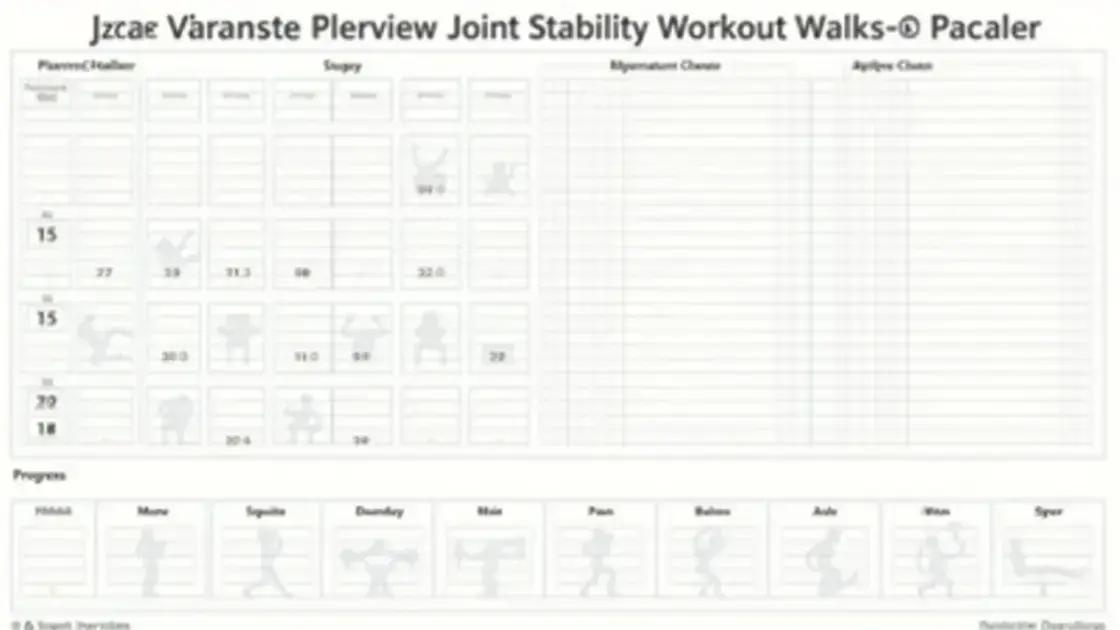The best workouts to improve joint stability include exercises like squats, lunges, planks, and balance training, which enhance strength and mobility while reducing the risk of injury. Creating a tailored workout plan can lead to better performance and overall joint health.
Improving your joint stability through effective workouts is essential to prevent injuries and enhance your athletic performance. Joint stability refers to how well your joints are maintained in their proper position during movement, and it’s crucial for overall physical health. In this article, we will explore some of the best workouts to improve joint stability, as well as the benefits you’ll reap from these exercises. From functional strength training to mobility exercises, we will provide you with a comprehensive guide to strengthen your joints effectively.
Understanding Joint Stability

Understanding joint stability is vital to maintaining a healthy and active lifestyle. Joint stability refers to the ability of joints to stay in position during movement. When your joints are stable, they can effectively support your body’s weight and movements. This stability is crucial during physical activities like running, jumping, or even walking.
Joint stability relies on a combination of factors, including strong muscles, connective tissues, and proper alignment of the bones. Muscles surrounding a joint play a critical role in keeping it stable. When these muscles are strong and well-coordinated, they can help prevent injuries and reduce the risk of joint pain.
The Role of Muscles in Joint Stability
The major muscle groups surrounding joints, such as your knees and hips, provide essential support. For instance, the quadriceps and hamstrings work together to stabilize the knee joint. Similarly, the gluteal muscles are crucial for stabilizing the hip joint. Strengthening these muscles through targeted exercises is essential to improving overall joint stability.
Importance of Proprioception
Another key aspect of joint stability is proprioception, the body’s ability to sense its position and movements. Proper proprioception helps you react to changes in the environment and maintains balance. Activities that enhance proprioception, like balance training and coordination exercises, improve joint stability.
In summary, understanding joint stability involves recognizing how muscles and proprioception contribute to keeping your joints healthy and functional. By focusing on joint stability, you can enhance your performance and minimize the risk of injuries during physical activities.
Top Exercises for Joint Strength

Top exercises for joint strength are designed to improve stability and enhance overall mobility. These exercises target the muscles around your joints, helping to fortify and protect them from injury.
1. Squats
Squats are excellent for building strength in the legs and core. Stand with your feet shoulder-width apart. Slowly bend your knees and lower your body as if you are sitting in a chair. Keep your chest up and push through your heels to return to standing.
2. Lunges
Lunges help strengthen the muscles around the knees and hips. Step forward with one foot and lower your hips until both knees are at 90-degree angles. Return to the starting position and switch legs.
3. Planks
Planks enhance core stability, which is vital for joint support. Start in a push-up position but rest on your forearms. Keep your body in a straight line from head to heels. Hold for as long as you can, focusing on maintaining your position.
4. Deadlifts
Deadlifts strengthen the lower back, glutes, and hamstrings. Stand with your feet hip-width apart, holding a weight in front of your thighs. Hinge at your hips, keeping your back straight, and lower the weight toward the ground. Lift back up by driving through your heels.
5. Balance Exercises
Balance exercises, such as standing on one leg, help improve proprioception and joint stability. Stand on one leg for 30 seconds, then switch. To make it harder, try closing your eyes or standing on a cushion.
Incorporating these exercises into your routine can significantly enhance joint strength. Aim for at least two to three sessions per week to see the best results.
Benefits of Improved Joint Stability

Benefits of improved joint stability extend beyond just preventing injuries. When your joints are stable, you can move more efficiently and safely. Here are some key benefits:
1. Reduced Risk of Injury
Enhanced joint stability significantly lowers the likelihood of injuries during physical activities. Stronger muscles and better alignment help support the joints, preventing strains and sprains.
2. Enhanced Performance
Improved stability allows for better movement mechanics, which can lead to enhanced athletic performance. Whether you’re running, lifting, or participating in sports, stable joints help you perform at your best.
3. Better Balance and Coordination
With improved joint stability, your balance and coordination also increase. This is crucial for daily activities, sports, and preventing falls, especially as you age.
4. Relief from Joint Pain
Stability can alleviate discomfort and pain in the joints. When the supporting structures around your joints are strong, they take pressure off the joints themselves, reducing pain and inflammation.
5. Enhanced Mobility
As your joint stability improves, so does your overall mobility. You will find it easier to perform everyday tasks, as well as engage in physical activities without discomfort.
Overall, focusing on joint stability offers numerous advantages that enhance quality of life and promote long-term health.
Creating a Joint Stability Workout Plan

Creating a joint stability workout plan requires careful consideration of your goals, current fitness level, and the exercises included. Here are steps to help you develop an effective plan:
1. Assess Your Current Level
Before starting, evaluate your current stability and strength. Consider consulting a fitness professional or physical therapist to understand your needs better and identify any areas of concern.
2. Set Specific Goals
Define what you want to achieve with your workout plan. Do you want to improve sports performance, reduce pain, or simply enhance daily movement? Clear goals will guide your exercise selection.
3. Choose the Right Exercises
Incorporate a mix of strength, balance, and flexibility exercises. Include the following:
- Squats: Strengthen the legs.
- Lunges: Build stability in knees and hips.
- Planks: Enhance core stability.
- Balance Exercises: Improve proprioception.
4. Structure Your Workouts
Schedule workouts for three to four times a week. Each session should include:
- Warm-Up: 5-10 minutes of dynamic stretching.
- Main Workout: 20-30 minutes of selected exercises.
- Cool Down: 5-10 minutes of static stretching.
5. Monitor Your Progress
Keep track of your workouts and observe how your stability improves. Adjust your plan every few weeks based on your progress and comfort level.
By carefully creating your joint stability workout plan, you can significantly enhance your physical health and mobility.
Enhancing Your Mobility Through Joint Stability
Improving joint stability through effective workouts is essential for anyone seeking to enhance their overall mobility and reduce the risk of injuries. As we’ve explored, understanding joint stability and incorporating targeted exercises can lead to numerous benefits such as better performance, improved balance, and relief from pain.
Creating a well-structured joint stability workout plan tailored to your needs is vital. By following the steps provided, you can monitor your progress and make adjustments as necessary to achieve your fitness goals.
Remember that consistent efforts in strengthening your joints today will pave the way for a healthier and more active lifestyle tomorrow.
FAQ – Frequently Asked Questions about Joint Stability and Workouts
What is joint stability?
Joint stability refers to the ability of a joint to maintain its proper position during movement, ensuring effective support and preventing injuries.
Why is improving joint stability important?
Improving joint stability enhances mobility, reduces the risk of injuries, and improves overall athletic performance and daily activities.
What exercises should I include in a joint stability workout plan?
Key exercises include squats, lunges, planks, balance exercises, and deadlifts, which target the muscles surrounding your joints.
How often should I work on joint stability?
Aim for three to four workouts per week focused on joint stability, incorporating a mix of strength, balance, and flexibility exercises.
Can I see improvements in my joint stability quickly?
While some improvements may be noticeable within a few weeks, significant gains in joint stability typically take consistent effort over time.
Do I need to consult a professional to create a workout plan?
While it’s beneficial to consult a fitness professional for personalized advice, you can also create a plan based on general guidelines tailored to your comfort and fitness level.












